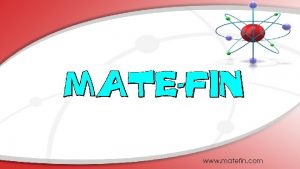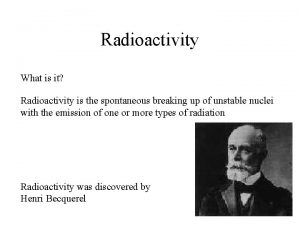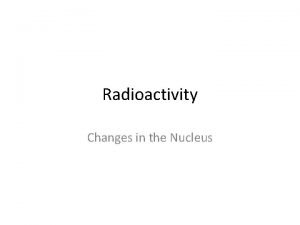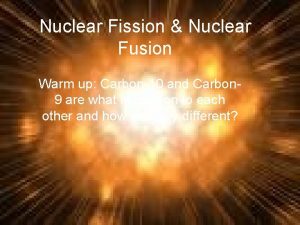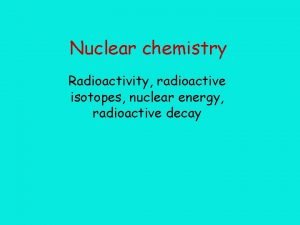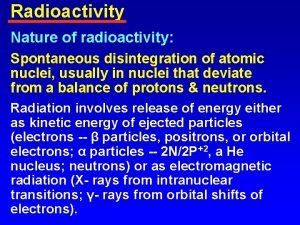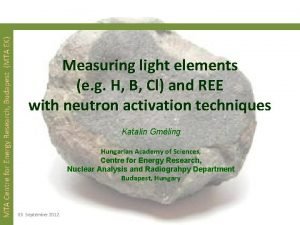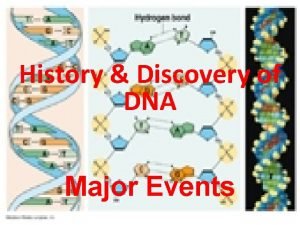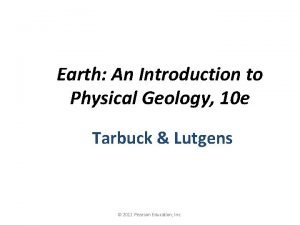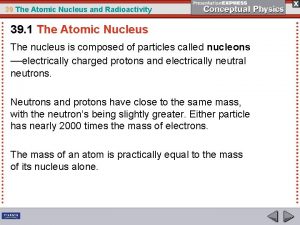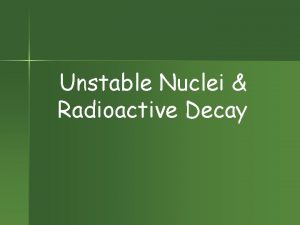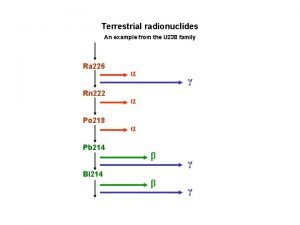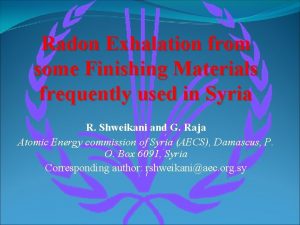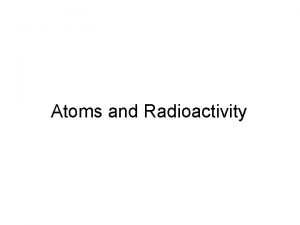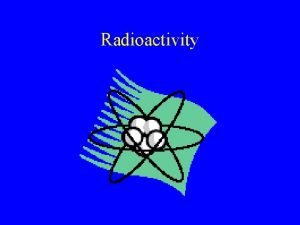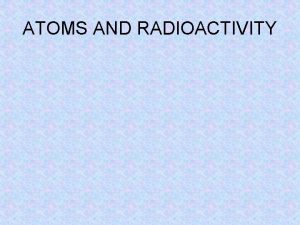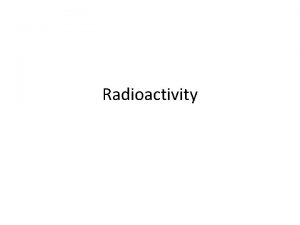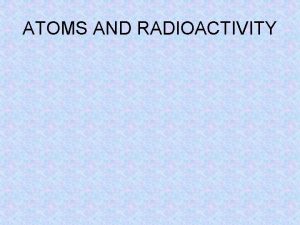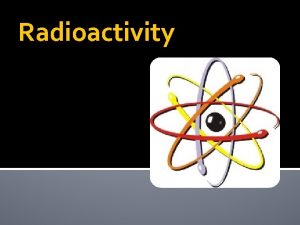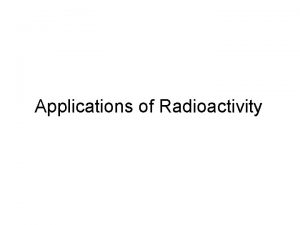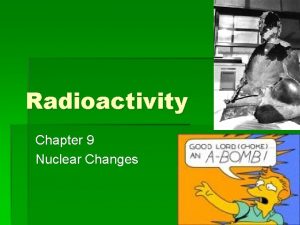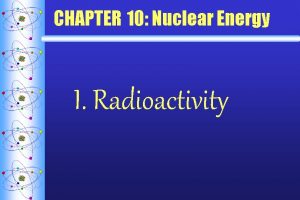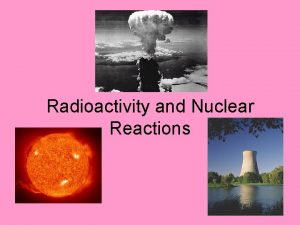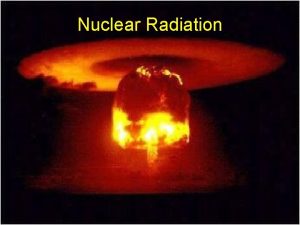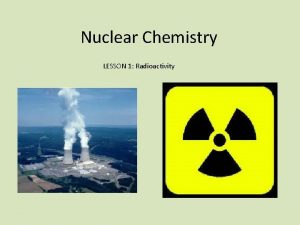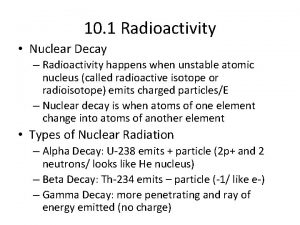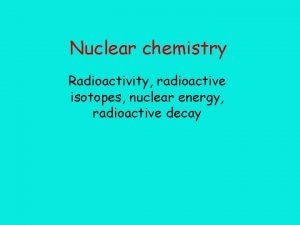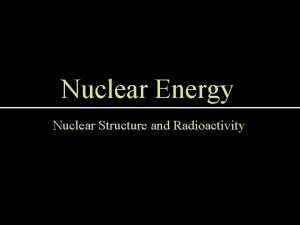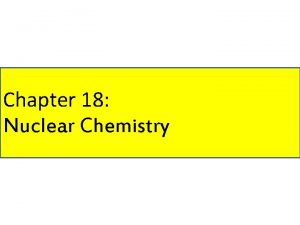Chapter 1 Nuclear Energy I Radioactivity A Definitions


















- Slides: 18

Chapter 1 Nuclear Energy I. Radioactivity

A. Definitions ª Radioactivity w emission of high-energy radiation from the nucleus of an atom ª Nuclide w nucleus of an isotope ª Transmutation w process of changing one element into another via nuclear decay

B. Types of Radiation ª Alpha ( ) w helium nucleus 2+ paper ª Beta-minus ( -) w electron 1 - lead ª Gamma ( ) w high-energy photon 0 concrete

C. Nuclear Decay ª Why nuclides decay… w to obtain a stable ratio of neutrons to protons Stable Unstable (radioactive)

C. Nuclear Decay TRANSMUTATION ª Alpha Emission ª Beta Emission

D. Half-life ª Half-life (t½) w time it takes for half of the nuclides in a sample to decay Example Half-lives polonium-194 0. 7 seconds lead-212 10. 6 hours iodine-131 8. 04 days carbon-14 5, 370 years uranium-238 4. 5 billion years

D. Half-life ª How much of a 20 -g sample of sodium-24 would remain after decaying for 30 hours? Sodium-24 has a half-life of 15 hours. GIVEN: WORK: total time = 30 hours number of half-lives = 2 t 1/2 = 15 hours 20 g ÷ 2 = 10 g (1 half-life) original mass = 20 g 10 g ÷ 2 = 5 g (2 half-lives) 5 g of 24 Na would remain.

CHAPTER 10 Nuclear Energy II. Nuclear Reactions (p. 689 -691)

A. F ission ª splitting a nucleus into two or more smaller nuclei ª some mass is converted to large amounts of energy

A. F ission ª chain reaction - self-feeding reaction

B. Fusion ª combining of two nuclei to form one nucleus of larger mass ª produces even more energy than fission ª occurs naturally in stars

Nuclear Energy III. Applications

A. Nuclear Power ª Fission Reactors Cooling Tower

A. Nuclear Power ª Fission Reactors

A. Nuclear Power ª Fusion Reactors (not yet sustainable)

A. Nuclear Power ª Fusion Reactors (not yet sustainable) National Spherical Torus Experiment Tokamak Fusion Test Reactor Princeton University

A. Nuclear Power F I S S I O N ª 235 U is limited ª danger of meltdown ª toxic waste ª thermal pollution vs. F U S I O N ª Hydrogen is abundant ª no danger of meltdown ª no toxic waste ª not yet sustainable

B. Others ª Choose one of the following to investigate: w Irradiated Food w Radioactive Dating w Nuclear Medicine Make a mini-poster in your book to display what you have learned.
 Key terms radioactivity and nuclear reactions
Key terms radioactivity and nuclear reactions Lesson 15 nuclear quest nuclear reactions
Lesson 15 nuclear quest nuclear reactions Fisión nuclear vs fision nuclear
Fisión nuclear vs fision nuclear Natural and artificial radioactivity
Natural and artificial radioactivity Natural transmutation example
Natural transmutation example Who discovered radioactivity
Who discovered radioactivity Who discovered radioactivity
Who discovered radioactivity Who discovered uranium
Who discovered uranium Natural and artificial radioactivity
Natural and artificial radioactivity Law of radioactive decay
Law of radioactive decay Radioactivity as spontaneous disintegration
Radioactivity as spontaneous disintegration Radioactivity
Radioactivity Radioactivity
Radioactivity The great unconformity
The great unconformity Atoms and radioactivity
Atoms and radioactivity Natural radioactivity
Natural radioactivity Environmental radioactivity
Environmental radioactivity Natural radioactivity
Natural radioactivity Radioactivity phenomenon
Radioactivity phenomenon



